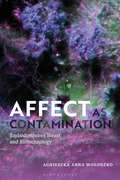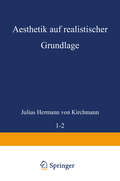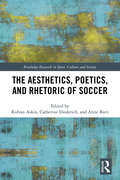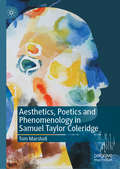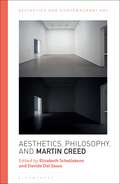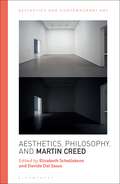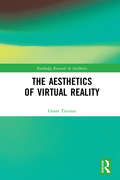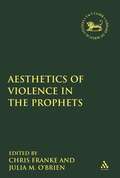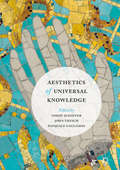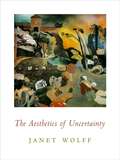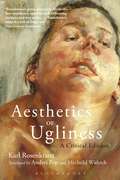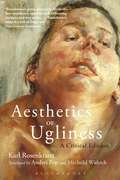- Table View
- List View
Affect as Contamination: Embodiment in Bioart and Biotechnology
by Agnieszka WolodzkoBringing the concept of contamination into dialogue with affect theory and bioart, Agnieszka Wolodzko urges us to rethink our relationship with ourselves, each other and other organisms. Thinking through the lens of contamination, this book provides an innovative approach to understanding the leaky, porous and visceral nature of our bodies and their endless interrelationships and, in doing so, uncovers new ways for thinking about embodiment. Affect theory has long been interested in transmission or contagion but, inspired by Spinoza and Deleuze, Affect as Contamination goes further, as contamination is concerned with the materiality of bodies and their affective encounter with other matter. This brings urgency to the notion of affect, not only for bioart that works with risky bodies but also for understanding how to practise our bodies in the age of biotechnological manipulation and governance. Using challenging and transgressive bioart projects as provocative case studies for rethinking affect and bodily practice, Wolodzko follows various 'contaminants' from blood, hormones and viruses to food, glitter and plants. This takes the form of both personal accounts of encounters with the contaminations of bioart and critical analyses of aesthetic, material and technical objects, with each one highlighting in different ways the risky and uncertain nature of contamination. Affect as Contamination is an urgent and original meditation on just what it means to be living, and practising our bodies, in an era where biotechnology contaminates all aspects of our lives.
Affect as Contamination: Embodiment in Bioart and Biotechnology
by Agnieszka WolodzkoBringing the concept of contamination into dialogue with affect theory and bioart, Agnieszka Wolodzko urges us to rethink our relationship with ourselves, each other and other organisms. Thinking through the lens of contamination, this book provides an innovative approach to understanding the leaky, porous and visceral nature of our bodies and their endless interrelationships and, in doing so, uncovers new ways for thinking about embodiment. Affect theory has long been interested in transmission or contagion but, inspired by Spinoza and Deleuze, Affect as Contamination goes further, as contamination is concerned with the materiality of bodies and their affective encounter with other matter. This brings urgency to the notion of affect, not only for bioart that works with risky bodies but also for understanding how to practise our bodies in the age of biotechnological manipulation and governance. Using challenging and transgressive bioart projects as provocative case studies for rethinking affect and bodily practice, Wolodzko follows various 'contaminants' from blood, hormones and viruses to food, glitter and plants. This takes the form of both personal accounts of encounters with the contaminations of bioart and critical analyses of aesthetic, material and technical objects, with each one highlighting in different ways the risky and uncertain nature of contamination. Affect as Contamination is an urgent and original meditation on just what it means to be living, and practising our bodies, in an era where biotechnology contaminates all aspects of our lives.
Aesthetics: Volume 1
by G. W. HegelIn his Aesthetics Hegel gives full expression to his seminal theory of art. He surveys the history of art from ancient India, Egypt, and Greece through to the Romantic movement of his own time, criticizes major works, and probes their meaning and significance; his rich array of examples gives broad scope for his judgement and makes vivid his exposition of his theory. The substantial Introduction is Hegel's best exposition of his general philosophy of art, and provides the ideal way into his Aesthetics. In Part I he considers the general nature of art: he distinguishes art, as a spiritual experience, from religion and philosophy; he discusses the beauty of art and differentiates it from the beauty of nature; and he examines artistic genius and originality. Part II provides a sort of history of art, divded into three periods called Symbolic (India, Persia, Egypt), Classical (Greece), and Romantic (medieval and post-medieval up to the end of the eighteenth century). Part III deals individually with architecture, scuplture, painting, music, and literature.
Aesthetics: A Very Short Introduction (Very Short Introductions)
by Bence NanayAesthetics is a branch of philosophy that explores the nature of art, beauty, and taste. It doesn't just consider traditional artistic experiences such as artworks in a museum or an opera performance, but also everyday experiences such as autumn leaves in the park, or even just the light of the setting sun falling on the kitchen table. It is also about your experience when you choose the shirt you're going to wear today or when you wonder whether you should put more pepper in the soup. Aesthetics is everywhere. It is one of the most important aspects of our life. In this Very Short Introduction Bence Nanay introduces the field of aesthetics, considering both Western and non-Western aesthetic traditions, and exploring why it is sometimes misunderstood or considered to be too elitist - by artists, musicians, and even philosophers. As Nanay shows, so-called 'high art' has no more claims on aesthetics than sitcoms, tattoos, or punk rock. In fact, the scope of aesthetics extends far wider than that of art, high or low, including much of what we care about in life. It is not the job of aesthetics to tell you which artworks are good and which ones are bad. It is not the job of aesthetics to tell you what experiences are worth having. If an experience is worth having for you, it thereby becomes the subject of aesthetics. This realisation is important, because thinking about aesthetics in this inclusive way opens up new ways of understanding old questions about the social aspect of our aesthetic engagements, and the importance of aesthetic values for our own self. ABOUT THE SERIES: The Very Short Introductions series from Oxford University Press contains hundreds of titles in almost every subject area. These pocket-sized books are the perfect way to get ahead in a new subject quickly. Our expert authors combine facts, analysis, perspective, new ideas, and enthusiasm to make interesting and challenging topics highly readable.
Aesthetics: A Very Short Introduction (Very Short Introductions)
by Bence NanayAesthetics is a branch of philosophy that explores the nature of art, beauty, and taste. It doesn't just consider traditional artistic experiences such as artworks in a museum or an opera performance, but also everyday experiences such as autumn leaves in the park, or even just the light of the setting sun falling on the kitchen table. It is also about your experience when you choose the shirt you're going to wear today or when you wonder whether you should put more pepper in the soup. Aesthetics is everywhere. It is one of the most important aspects of our life. In this Very Short Introduction Bence Nanay introduces the field of aesthetics, considering both Western and non-Western aesthetic traditions, and exploring why it is sometimes misunderstood or considered to be too elitist - by artists, musicians, and even philosophers. As Nanay shows, so-called 'high art' has no more claims on aesthetics than sitcoms, tattoos, or punk rock. In fact, the scope of aesthetics extends far wider than that of art, high or low, including much of what we care about in life. It is not the job of aesthetics to tell you which artworks are good and which ones are bad. It is not the job of aesthetics to tell you what experiences are worth having. If an experience is worth having for you, it thereby becomes the subject of aesthetics. This realisation is important, because thinking about aesthetics in this inclusive way opens up new ways of understanding old questions about the social aspect of our aesthetic engagements, and the importance of aesthetic values for our own self. ABOUT THE SERIES: The Very Short Introductions series from Oxford University Press contains hundreds of titles in almost every subject area. These pocket-sized books are the perfect way to get ahead in a new subject quickly. Our expert authors combine facts, analysis, perspective, new ideas, and enthusiasm to make interesting and challenging topics highly readable.
Aesthetics, Politics, Pedagogy and Tagore: A Transcultural Philosophy of Education (Palgrave Studies in Education and Transculturalism)
by Ranjan GhoshThis book provides a radical rethinking of the prominent Indian thinker Rabindranath Tagore, exploring how his philosophy of education relates to the ideas of Western theorists such as Kant, Plato and Aristotle. Tagore's thoughts on pedagogy, university and formal education are subjected to a fascinating critique within Ghosh's transcultural framework, referencing a wide range of thinkers across varying time periods, places, and cultures, and developing a greater sensitivity to other traditions, languages, and forms of thinking and writing. The book changes the way we have so far thought about the educationist Tagore, and will be of interest to scholars and specialists of literature, Indian history, and philosophy of education. It is political, deeply philosophical and has a transcultural take on our understanding of a variety of issues relating to Tagore and to philosophy of education in general.
The Aesthetics, Poetics, and Rhetoric of Soccer (Routledge Research in Sport, Culture and Society)
by Ridvan Askin Catherine Diederich Aline BieriSoccer has long been known as 'the beautiful game'. This multi-disciplinary volume explores soccer, soccer culture, and the representation of soccer in art, film, and literature, using the critical tools of aesthetics, poetics, and rhetoric. Including international contributions from scholars of philosophy, literary and cultural studies, linguistics, art history, and the creative arts, this book begins by investigating the relationship between beauty and soccer and asks what criteria should be used to judge the sport’s aesthetic value. Covering topics as diverse as humor, national identity, style, celebrity, and social media, its chapters examine the nature of fandom, the role of language, and the significance of soccer in contemporary popular culture. It also discusses what one might call the ‘stylistics’ of soccer, analyzing how players, fans, and commentators communicate on and off the pitch, in the press, on social media, and in wider public discourse. The Aesthetics, Poetics, and Rhetoric of Soccer makes for fascinating reading for anybody with an interest in sport, culture, literature, philosophy, linguistics, and society.
The Aesthetics, Poetics, and Rhetoric of Soccer (Routledge Research in Sport, Culture and Society)
Soccer has long been known as 'the beautiful game'. This multi-disciplinary volume explores soccer, soccer culture, and the representation of soccer in art, film, and literature, using the critical tools of aesthetics, poetics, and rhetoric. Including international contributions from scholars of philosophy, literary and cultural studies, linguistics, art history, and the creative arts, this book begins by investigating the relationship between beauty and soccer and asks what criteria should be used to judge the sport’s aesthetic value. Covering topics as diverse as humor, national identity, style, celebrity, and social media, its chapters examine the nature of fandom, the role of language, and the significance of soccer in contemporary popular culture. It also discusses what one might call the ‘stylistics’ of soccer, analyzing how players, fans, and commentators communicate on and off the pitch, in the press, on social media, and in wider public discourse. The Aesthetics, Poetics, and Rhetoric of Soccer makes for fascinating reading for anybody with an interest in sport, culture, literature, philosophy, linguistics, and society.
Aesthetics, Poetics and Phenomenology in Samuel Taylor Coleridge
by Tom MarshallThis book re-evaluates the philosophical status of Samuel Taylor Coleridge by providing an extended comparison between his work and the phenomenological theory of Edmund Husserl. Examining Coleridge’s accounts of the imagination, perception, poetic creativity and literary criticism, it draws a systematic and coherent structure out of a range of Coleridge’s philosophical writing. In addition, it also applies the principles of Coleridge’s philosophy to an interpretation of his own poetic output.
Aesthetics, Philosophy and Martin Creed (Aesthetics and Contemporary Art)
by Elisabeth Schellekens and Davide Dal SassoWhat is the future of conceptualism? What expressions can it take in the 21st century? Is there a new role for aesthetic experience in art and, if so, what is that role exactly? Aesthetics, Philosophy and Martin Creed uses one of this generation's most important and influential artists to address themes crucial to contemporary aesthetics. Working in an impressive variety of artistic media, Creed represents a strikingly innovative take on conceptualism. Through his ingenious and thought-provoking work, a team of international philosophers, jurists and art historians illustrate how Creed epitomizes several questions central to philosophical aesthetics today and provides a glimpse of the future both of art and aesthetic discourse. They discuss key concepts for Creed's work, including immediacy (in his photographs of smiling people), compositional order (in his geometric paintings), simplicity (in Work No. 218, a sheet paper crumpled into a ball) and shamelessness (in his videos of vomiting people). By bringing a working artist into the heart of academic discussions, Aesthetics, Philosophy and Martin Creed highlights the relevance of philosophical discussions of art to understanding art today.
Aesthetics, Philosophy and Martin Creed (Aesthetics and Contemporary Art)
by Elisabeth Schellekens Davide Dal SassoWhat is the future of conceptualism? What expressions can it take in the 21st century? Is there a new role for aesthetic experience in art and, if so, what is that role exactly? Aesthetics, Philosophy and Martin Creed uses one of this generation's most important and influential artists to address themes crucial to contemporary aesthetics. Working in an impressive variety of artistic media, Creed represents a strikingly innovative take on conceptualism. Through his ingenious and thought-provoking work, a team of international philosophers, jurists and art historians illustrate how Creed epitomizes several questions central to philosophical aesthetics today and provides a glimpse of the future both of art and aesthetic discourse. They discuss key concepts for Creed's work, including immediacy (in his photographs of smiling people), compositional order (in his geometric paintings), simplicity (in Work No. 218, a sheet paper crumpled into a ball) and shamelessness (in his videos of vomiting people). By bringing a working artist into the heart of academic discussions, Aesthetics, Philosophy and Martin Creed highlights the relevance of philosophical discussions of art to understanding art today.
Aesthetics on the Edge: Where Philosophy Meets the Human Sciences
by Dominic McIver LopesPhilosophers say what art is and then scientists and then other scholars study how we are equipped, cognitively and socially, to make art and appreciate it. This time-honoured approach will not work. Recent science reveals that we have poor intuitive access to artistic and aesthetic phenomena. Dominic McIver Lopes argues for a new approach that mandates closer integration, from the start, between aesthetics and the human sciences. In these eleven essays he proposes a methodology especially suited to aesthetics, where problems in philosophy are addressed principally by examining how aesthetic phenomena are understood in the human sciences. Since the human sciences include much of the humanities as well as the social, behavioural, and brain sciences, the methodology promises to integrate arts research across the academy. Aesthetics on the Edge opens with a four essays outlining the methodology and its potential. The following essays put the methodology to work, shedding light on the perceptual and social-pragmatic capacities that are implicated in responding to works of art, especially images, but also music, literature, and conceptual art.
Aesthetics on the Edge: Where Philosophy Meets the Human Sciences
by Dominic McIver LopesPhilosophers say what art is and then scientists and then other scholars study how we are equipped, cognitively and socially, to make art and appreciate it. This time-honoured approach will not work. Recent science reveals that we have poor intuitive access to artistic and aesthetic phenomena. Dominic McIver Lopes argues for a new approach that mandates closer integration, from the start, between aesthetics and the human sciences. In these eleven essays he proposes a methodology especially suited to aesthetics, where problems in philosophy are addressed principally by examining how aesthetic phenomena are understood in the human sciences. Since the human sciences include much of the humanities as well as the social, behavioural, and brain sciences, the methodology promises to integrate arts research across the academy. Aesthetics on the Edge opens with a four essays outlining the methodology and its potential. The following essays put the methodology to work, shedding light on the perceptual and social-pragmatic capacities that are implicated in responding to works of art, especially images, but also music, literature, and conceptual art.
The Aesthetics of Virtual Reality (Routledge Research in Aesthetics)
by Grant TavinorThis is the first book to present an aesthetics of virtual reality media. It situates virtual reality media in terms of the philosophy of the arts, comparing them to more familiar media such as painting, film and photography. When philosophers have approached virtual reality, they have almost always done so through the lens of metaphysics, asking questions about the reality of virtual items and worlds, about the value of such things, and indeed, about how they may reshape our understanding of the "real" world. Grant Tavinor finds that approach to be fundamentally mistaken, and that to really account for virtual reality, we must focus on the medium and its uses, and not the hypothetical and speculative instances that are typically the focus of earlier works. He also argues that much of the cultural and metaphysical hype around virtual reality is undeserved. But this does not mean that virtual reality is illusory or uninteresting; on the contrary, it is significant for the altogether different reason that it overturns much of our understanding of how representational media can function and what we can use them to achieve. The Aesthetics of Virtual Reality will be of interest to scholars and advanced students working in aesthetics, philosophy of art, philosophy of technology, metaphysics, and game studies.
The Aesthetics of Virtual Reality (Routledge Research in Aesthetics)
by Grant TavinorThis is the first book to present an aesthetics of virtual reality media. It situates virtual reality media in terms of the philosophy of the arts, comparing them to more familiar media such as painting, film and photography. When philosophers have approached virtual reality, they have almost always done so through the lens of metaphysics, asking questions about the reality of virtual items and worlds, about the value of such things, and indeed, about how they may reshape our understanding of the "real" world. Grant Tavinor finds that approach to be fundamentally mistaken, and that to really account for virtual reality, we must focus on the medium and its uses, and not the hypothetical and speculative instances that are typically the focus of earlier works. He also argues that much of the cultural and metaphysical hype around virtual reality is undeserved. But this does not mean that virtual reality is illusory or uninteresting; on the contrary, it is significant for the altogether different reason that it overturns much of our understanding of how representational media can function and what we can use them to achieve. The Aesthetics of Virtual Reality will be of interest to scholars and advanced students working in aesthetics, philosophy of art, philosophy of technology, metaphysics, and game studies.
The Aesthetics of Violence in the Prophets (The Library of Hebrew Bible/Old Testament Studies)
by Julia M. O'Brien Chris FrankeAt the 2006 annual meeting of the Society of Biblical Literature, the Prophetic Texts in their Ancient Contexts section devoted a session to the theme "The Aesthetics of Violence." Participants were invited to explore multiple dimensions of prophetic texts and their violent rhetoric. The results were rich-- engaging discussion of violent images in ancient Near Eastern art and in modern film, as well as advancing our understanding of the poetic skill required for invoking terror through words.This volume collects those essays as well as others especially commissioned for its creation. As a collection, they address questions that are at once ancient and distressingly-modern: What do violent images do to us? Do they encourage violent behavior and/or provide an alternative to actual violence? How do depictions of violence define boundaries between and within communities? What readers can and should readers make of the disturbing rhetoric of violent prophets? Contributors include Corrine Carvahlo, Cynthia Chapman, Chris Franke, Bob Haak, Mary Mills, Julia O'Brien, Kathleen O'Connor, Carolyn Sharp, Yvonne Sherwood, and Daniel Smith-Christopher.
The Aesthetics of Videogames (Routledge Research in Aesthetics)
by Jon Robson Grant TavinorThis collection of essays is devoted to the philosophical examination of the aesthetics of videogames. Videogames represent one of the most significant developments in the modern popular arts, and it is a topic that is attracting much attention among philosophers of art and aestheticians. As a burgeoning medium of artistic expression, videogames raise entirely new aesthetic concerns, particularly concerning their ontology, interactivity, and aesthetic value. The essays in this volume address a number of pressing theoretical issues related to these areas, including but not limited to: the nature of performance and identity in videogames; their status as an interactive form of art; the ethical problems raised by violence in videogames; and the representation of women in videogames and the gaming community. The Aesthetics of Videogames is an important contribution to analytic aesthetics that deals with an important and growing art form.
The Aesthetics of Videogames (Routledge Research in Aesthetics)
by Jon Robson Grant TavinorThis collection of essays is devoted to the philosophical examination of the aesthetics of videogames. Videogames represent one of the most significant developments in the modern popular arts, and it is a topic that is attracting much attention among philosophers of art and aestheticians. As a burgeoning medium of artistic expression, videogames raise entirely new aesthetic concerns, particularly concerning their ontology, interactivity, and aesthetic value. The essays in this volume address a number of pressing theoretical issues related to these areas, including but not limited to: the nature of performance and identity in videogames; their status as an interactive form of art; the ethical problems raised by violence in videogames; and the representation of women in videogames and the gaming community. The Aesthetics of Videogames is an important contribution to analytic aesthetics that deals with an important and growing art form.
Aesthetics of Universal Knowledge
by Simon Schaffer John Tresch Pasquale GagliardiBorn out of a major international dialogue held at the Fondazione Giorgio Cini in Venice, Italy, this collection of essays presents innovative and provocative arguments about the claims of universal knowledge schemes and the different aesthetic and material forms in which such claims have been made and executed. Contributors take a close look at everything from religious pilgrimages, museums, and maps of the world, to search engines and automated GPS.Current obsessions in information technology, communications theory, and digital culture often concern the value and possibility of a grand accumulation of universally accessible forms of knowledge: total libraries, open data bases, ubiquitous computing, and ‘smart’ technologies. These obsessions have important social and philosophical origins, and they raise profound questions about the very nature of knowledge and its organization. This volume’s contributors draw on the histories of maps and of encyclopedias, worldviews and visionary collections, to make sense of the crucial relation between the way the world is known and how it might be displayed and transformed.
Aesthetics of Universal Knowledge
by Simon Schaffer John Tresch Pasquale GagliardiBorn out of a major international dialogue held at the Fondazione Giorgio Cini in Venice, Italy, this collection of essays presents innovative and provocative arguments about the claims of universal knowledge schemes and the different aesthetic and material forms in which such claims have been made and executed. Contributors take a close look at everything from religious pilgrimages, museums, and maps of the world, to search engines and automated GPS.Current obsessions in information technology, communications theory, and digital culture often concern the value and possibility of a grand accumulation of universally accessible forms of knowledge: total libraries, open data bases, ubiquitous computing, and ‘smart’ technologies. These obsessions have important social and philosophical origins, and they raise profound questions about the very nature of knowledge and its organization. This volume’s contributors draw on the histories of maps and of encyclopedias, worldviews and visionary collections, to make sense of the crucial relation between the way the world is known and how it might be displayed and transformed.
The Aesthetics Of Uncertainty (Columbia Themes In Philosophy, Social Criticism, And The Arts Ser.)
by Janet WolffAesthetics of Ugliness: A Critical Edition
by Karl RosenkranzIn this key text in the history of art and aesthetics, Karl Rosenkranz shows ugliness to be the negation of beauty without being reducible to evil, materiality, or other negative terms used it's conventional condemnation. This insistence on the specificity of ugliness, and on its dynamic status as a process afflicting aesthetic canons, reflects Rosenkranz's interest in the metropolis - like Walter Benjamin, he wrote on Paris and Berlin - and his voracious collecting of caricature and popular prints. Rosenkranz, living and teaching, like Kant, in remote Königsberg, reflects on phenomena of modern urban life from a distance that results in critical illumination. The struggle with modernization and idealist aesthetics makes Aesthetics of Ugliness, published four years before Baudelaire's Fleurs du Mal, hugely relevant to modernist experiment as well as to the twenty-first century theoretical revival of beauty.Translated into English for the first time, Aesthetics of Ugliness is an indispensable work for scholars and students of modern aesthetics and modernist art, literary studies and cultural theory, which fundamentally reworks conceptual understandings of what it means for a thing to be ugly.
Aesthetics of Ugliness: A Critical Edition
by Karl Rosenkranz Andrei Pop Mechtild WidrichIn this key text in the history of art and aesthetics, Karl Rosenkranz shows ugliness to be the negation of beauty without being reducible to evil, materiality, or other negative terms used it's conventional condemnation. This insistence on the specificity of ugliness, and on its dynamic status as a process afflicting aesthetic canons, reflects Rosenkranz's interest in the metropolis - like Walter Benjamin, he wrote on Paris and Berlin - and his voracious collecting of caricature and popular prints. Rosenkranz, living and teaching, like Kant, in remote Königsberg, reflects on phenomena of modern urban life from a distance that results in critical illumination. The struggle with modernization and idealist aesthetics makes Aesthetics of Ugliness, published four years before Baudelaire's Fleurs du Mal, hugely relevant to modernist experiment as well as to the twenty-first century theoretical revival of beauty.Translated into English for the first time, Aesthetics of Ugliness is an indispensable work for scholars and students of modern aesthetics and modernist art, literary studies and cultural theory, which fundamentally reworks conceptual understandings of what it means for a thing to be ugly.
Aesthetics of the Familiar: Everyday Life and World-Making
by Yuriko SaitoYuriko Saito explores the nature and significance of the aesthetic dimensions of people's everyday life. Everyday aesthetics has the recognized value of enriching one's life experiences and sharpening one's attentiveness and sensibility. Saito draws out its broader importance for how we make our worlds, environmentally, morally, as citizens and consumers. Saito urges that we have a social responsibility to encourage cultivation of aesthetic literacy and vigilance against aesthetic manipulation. Yuriko Saito argues that ultimately, everyday aesthetics can be an effective instrument for directing the humanity's collective and cumulative world-making project for the betterment of all its inhabitants. Everyday aesthetics has been seen as a challenge to contemporary Anglo-American aesthetics discourse, which is dominated by the discussion of art and beauty. Saito responds to controversies about the nature, boundary, and status of everyday aesthetics and argues for its legitimacy. She highlights the multi-faceted aesthetic dimensions of everyday life that are not fully accounted for by the commonly-held account of defamiliarizing the familiar.
